Ivar Christian Hallström was born in Stockholm on 5 June 1826 and died there on 11 April 1901. During the 19th century Hallström was Sweden’s most successful composer for opera, with works such as Den bergtagna and Vikingarna, the latter of which attained the status of national opera. Although mainly self-taught, Hallström was alone among his Swedish contemporaries in mastering the musical dramatic idiom. His feeling for dramatic increase and musical conciseness led to his operas placing not only in the Swedish opera milieu, but also in the central European opera tradition. Member of the Royal Swedish Academy of Music in 1861.
In an interview several years before his death in the French-English journal The Song Journal, Ivar Hallström summarised his life with the words: ‘I have lived a very happy life, without any major blows, with much applause and great successes and indeed quite a few minor impediments’ − a remark that reveals self-distance and distance to his own art, but that also implies a not entirely easy existence in the 19th century’s musical Sweden.
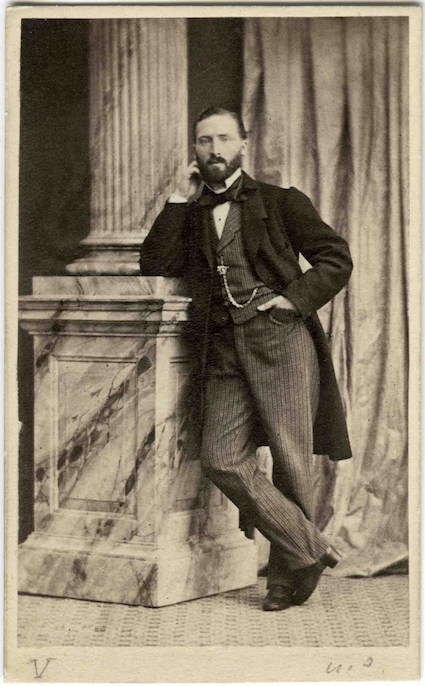
Early years
Ivar Hallström was the son of bank superintendent (a high ranking official in the Swedish central bank) Paul Fredrik Hallström and Anna Maria Casparsson. He started playing piano at the early age of four, and under the tutelage of Edmond Passy and Theodor Stein he became an accomplished pianist. Aside from his piano studies, he finished school in 1844 in Uppsala, following which he studied law, graduating with a degree in the same in 1849. Upon completion of his studies he held a series of different jobs in Stockholm’s law offices. During his time in Uppsala he had got to know Prince Gustaf, and found in him a good friend and mentor. The musically gifted Gustaf had composed music to the comic opera Hvita frun på Drottningholm in 1847, and Hallström had contributed a pair of musical numbers. The work was performed in 1847 at the Kungliga Teatern (the Royal Opera), however with limited success.
On Prince Gustaf’s initiative Ivar Hallström was employed as a librarian for the then Duke of Östergötland, who would later become King Oscar II. Hallström was hired in 1853 and held the position until his death. As part of this position Hallström was also required to assist the king at various musical events in the royal court, and to present new young singers to Oscar as potential recruits for the Kungliga Teatern, an activity that Hallström found both cumbersome and monotonous in his later years.
After a study trip to France, which involved new and vital musical impressions, Ivar Hallström left law. He dedicated himself entirely to composition from 1854. He was elected as a member of the Royal Swedish Academy of Music in 1861 and the same year he took over Adolf Fredrik Lindblad’s school of music, where he had been a piano teacher from its foundation. He ran the school until 1872 when it was closed down. Hallström’s output consisted up to the 1860’s mainly of Swedish romantic songs and smaller works for piano. In 1860 he debuted with the cantata Blommornas undran and later Herr Hjalmar och skön Ingrid, both of which were set to texts by Oscar Fredrik (the soon to be King Oscar II).
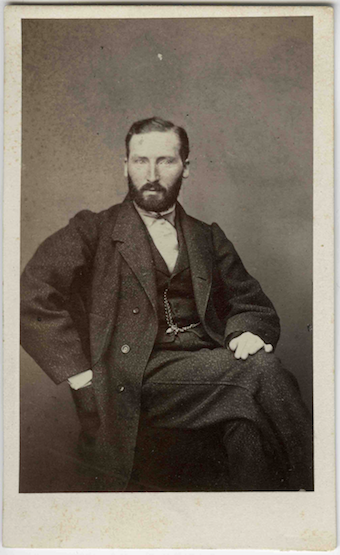
Ivar Hallström became a member of Kungl. Musikaliska akademien (The Royal Swedish Academy of music) in 1861.
The dramatic composer
Both of the above works could be seen as pre-studies for Hallström’s first work for the stage, Hertig Magnus och sjöjungfrun, which was produced in 1867. It was an immediate success, but as a result of a cast member’s illness only six performances took place. When the production restarted interest in it had waned. However, it showcased Hallström as a high calibre dramatic composer. His ability to capture the dramaturgical process with a distinct feeling for musical phrasing and harmonic colour had not previously been heard in Swedish music dramas. This resulted in a collaboration with Frans Hedberg, in whom Hallström found a first class librettist of international calibre. They later worked together on four operas.
In Hertig Magnus Hallström’s musical dramatic idiom is clear from the start: a rare ability to weave in a folk music tone, but without letting it become an adjusted art music version of folk music, and at the same time use this sound in a dramaturgical context. Hallström’s musical ideal was characteristically French with strong influences of, among others, Fromental Halévy and Charles Gounod, and some features of Giuseppe Verdi could also be made out in his work, as in the finale of the dramatic second act. Hertig Magnus aroused great interest in the press of the time, and music historian and critic Adolf Lindgren (1846−1905) wrote an enthusiastic article in Ny Illustrerad Tidning, in which the work was counted ‘among the greatest dramatic tone poems our country has to offer’.
Hallström’s success with Hertig Magnus led him to focus his production on music theatre. With it Hallström showed that he could master more than just the great dramatic expressions. During the following years he wrote operettas with clear influences of French opéra-comique: Den förtrollade katten (1869), Silverringen (1870), and Mjölnarvargen (1871), of which the first was a collaboration with Hedberg. In these works, Hallström’s weakness for spirited, snappy couplets in the style of Offenbach comes through, and even though the work does not share the same status as his operas, it shows his genuine feeling for timing and the dramatic line − Hallström’s trademark as a composer.
Ivar Hallström’s connection to the Kungliga Teatern had begun early for him with his employment as librarian and singing teacher for Oscar II in the beginning of the 1850s, and led, as previously mentioned, to his being appointed to bring forth promising talents who could potentially be hired at the opera. When the new ballet master was looking for an appropriate composer for full-length ballets in 1870, Hallström was a convenient choice. He composed three ballets: En dröm (1870), Ett äventyr i Skottland (1871) and Melusina (1882). The middle work was a collaboration with Conrad Nordqvist, and its fourteen numbers were divided evenly between the composers. At this time Nordqvist was the acting head of the chorus and the assistant conductor at the Kungliga Teatern. Hallström’s music in the ballets exposes his taste for the French: he was well acquainted with Léo Delibe’s Coppélia and Adolphe Adam’s Giselle, whose works were frequently performed at the opera.
Towards a Swedish national opera
In the beginning of the 1870’s Hallström, together with Frans Hedberg, started working on what would become his most popular and most performed work. The old nature-mythical ballad about the maiden who, on the way to the early service on Christmas Day, is kidnapped by the Mountain King and taken into the mountain to be his wife is a well-known theme in Sweden as well as in other Nordic cultures. From this story Hallström and Hedberg created Den bergtagna, a French grand opéra in five acts with grandiose scenography by Fredrik Wilhelm Scholander and Christian Jansson, and magnificent vocal passages and ballet choreography. The opera premiered in May 1874 and came at the time to be considered a Swedish national opera. By 1910 it had been performed 84 times.
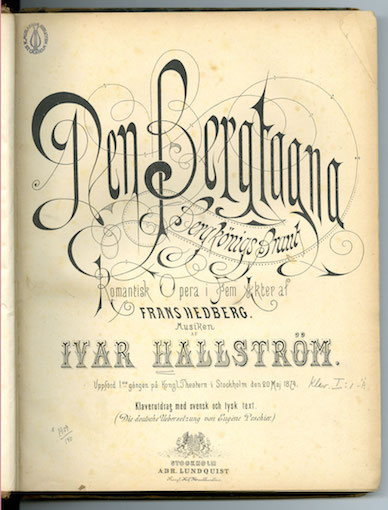
Hallström's opera "De Bergtagna" was the most performed Swedish opera of the 1800s.
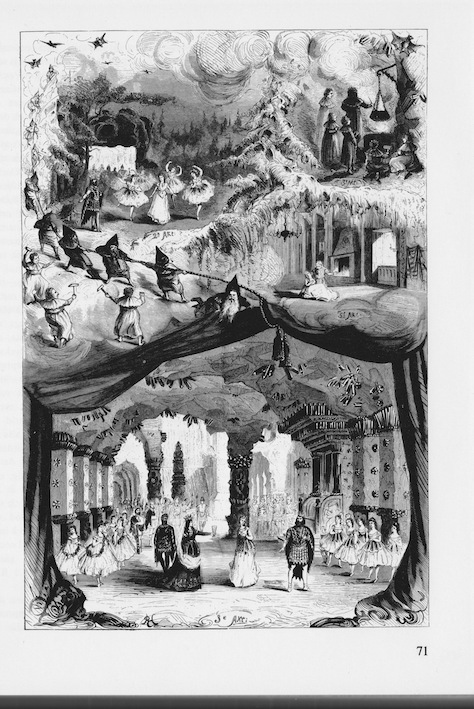
"De bergtagna", scenes from act II, III:1, III:2 and V. Wood engraving based on a drawing made by R Haglund.
The opera went through a series of revisions; the primary focus was to shorten it, as it was seen to be far too long. The different versions came in handy, however, and were used at productions in Munich, Copenhagen, and Hamburg. The work is divided up into individual numbers, but as a result of Hallström’s ability to combine rich musical themes and refined orchestration with dramaturgical precision, it is nonetheless his most elaborate and musically well-accomplished work. His collaboration with Frans Hedberg comprised two further works. Three years after Den bergtagna came Vikingarna (1877), a work in which the brusque and melancholy Nordic is contrasted with the light and sun-drenched image of Provence. The music has tangible Wagnerian influences, particularly in the depiction of the passionate relationship between Isaura of southern France and the Nordic viking Rolf. In terms of form it is Hallström’s most through-composed opera.
Continued work in opera
From 1881−85 Ivar Hallström was employed as the vocal instructor at the Kungliga Teatern, a position that is more or less the same as the répétiteur’s. During this time he trained three young singers: the tenors Arvid Ödmann and Olof Lemon, and baritone Oscar Bergström, all of whom came to form a strong core among the soloists at the Kungliga Teatern. In 1879 Hallström came into contact with Queen Elisabeth of Romania through his closeness with the royal court. The Queen was well known as an author of novels and plays under the pseudonym Carmen Sylva. She found in Hallström an artistic kinsman, and his visit in Romania with Arvid Ödmann was the inspiration for an opera in a Romanian environment: the revolutionary drama Neaga. As with Den bergtagna, the opera was written as a grand opéra, but was revised to four acts and premiered in February 1885 at Kungliga Teatern with significant success. The opera has a revolutionary theme and the music is kept to darker colours than in previous works. There are no allusions to Nordic folklore here, but Hallström had a good ear for folk music even outside of Sweden. In his travel diary he writes about a folk festival with Romanian folk music that he transcribed and later used in the opera’s ballet numbers. The music has an strange, genuine folk music sound due to Hallström’s completely avoiding a salon-style folk music arrangement, and he leaves the music more or less untouched, reproducing its irregular accents and pentatonic harmonies. This freshness also pervades the opera’s music in general.
During the 1880s a number of Ivar Hallström’s lesser works were also performed. Silferringen (1880, written 1870) was a social-realistic attempt at portraying the conditions at an English spinnery. In 1886 the operetta Aristoteles was performed at Nya teatern, followed by the fairy play Per Svinaherde in 1887. One opera Hallström worked on for the duration of the 1880s was Jaguarita l’Indienne, whose plot is set in India. The opera was grandiose in construction but was never produced, most likely due to the huge cost staging would have incurred.
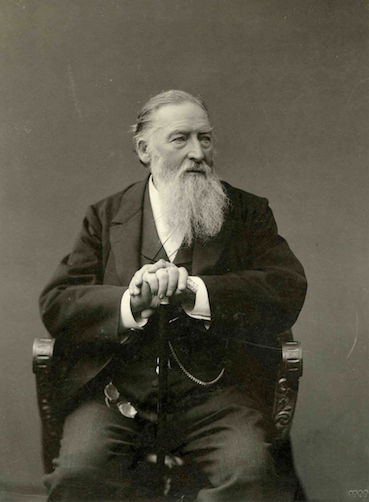
The 1890s brought about a reduced flow in Hallström’s music dramatic output. In 1892 Granadas dotter was produced, and its twelve performances came to be Hallström’s last premiere at the Kungliga Teatern. The work was well received, among other things for the refined and sonorically-advanced orchestration. In January 1894, in connection with the demolition of Gustav III’s opera house to make way for the current one, an opera competition was announced. Hallström and Hedberg submitted Liten Karin, an opera about Erik XIV and Karin Månsdotter. The five man prize jury found none of the submitted works worthy of first or second prize, but they awarded Hallström third prize and one thousand kronor, an overt demonstration of condescension towards Sweden’s most gifted musical dramatist. With the fairy play Hin Ondes snaror (1900), which was performed at Stora teatern in Gothenburg, Hallström bid farewell to the opera stage. He was weakened by a heart condition from which he suffered for many years, and he died in April 1901.
Significance
Ivar Hallström’s legacy is problematic. He was both celebrated and castigated by his contemporaries, and his memory faded from posterity. Hallström was a self-taught composer, and as such he was seen to be incapable of writing the orchestration for his operas, an opinion that is stubbornly held still today. Conrad Nordqvist is named as orchestrator for his works. He and Hallström were colleagues at the theatre and had additionally worked together on the ballet Ett äventyr i Skottland; no doubt Hallström found a good teacher in Nordqvist. However, all orchestra manuscripts are in Hallström’s hand, often re-touched fair copies. In addition, his orchestration manuscripts are of an elegant early romantic-classical style, while Nordqvist’s are rather stylistically similar to a more saturated orchestral sound. Despite his time’s and our time’s parsimonious attitude, Hallström experienced ‘much applause and great successes’, and with his generous reputation and good-natured temperament he was probably able to survive ‘quite a few minor impediments’. In spite of this, no other Swedish composer of opera has had fourteen operas produced at the Kungliga Teatern, and these with significant public acclaim.
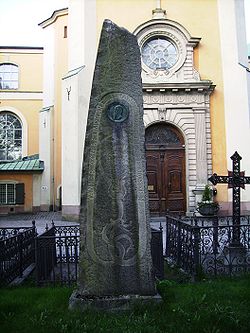
Ivar Hallström's tomb at Maria Magdalena churchyard in Stockholm.
Adolf Lindgren, who was initially gushingly enthusiastic over Hertig Magnus in 1867, kept a respectable distance to Ivar Hallström as a musical dramatist, and pinpricked the quality of his music. Hallström’s connection to the royal court, which without a doubt improved his chances of having his works performed at the Kungliga Teatern, also loomed large. Quotes such as the following (which Lindgren repeated in his obituary) may be seen as representative of the opinions the cultural elite of Sweden had of Hallström at the time: ‘We dare not say, if his muse, without the royal court’s often unhealthy influence, possibly could have developed heartier and more wholesome forms; the scent of wild twinflowers with which she loves to adorn herself are now undeniably somewhat overpoweringly mixed with the perfumes of the salon, in order that she be recognised as a full incarnation of the people’s patriotic song’.
Anders Wiklund © 2015
Trans. Nicole Vickers
Bibliography
Edholm, Erik af: Svunna dagar: ur förste hovmarskalken Erik af Edholms dagböcker. Tidsbilder från 1800-talet, utgivna av hans son, 3 vol. Stockholm: Norstedt, 1944−48.
Forslin, Alfhild: Runeberg i musiken, Helsingfors: Svenska litteratursällskapet, 1958, p. 326f.
Frimureriska tonsättare och frimurerisk musik, Uppsala: Forskningslogen Carl Friedrich Eckleff, 2006, p. 305
Gademan, Göran: Den bergtagna 1874−1987, bachelor’s thesis in performance studies, Stockholm University, 1988.
Gademan, Göran: ‘Hög tid för Hallström’, MD Musikdramatik, 2001:4, pp. 20−21.
Hedberg, Frans: ‘Ivar Hallström’, Svea, 1902.
Helmer, Axel: Svensk solosång 1850−1890. En genrehistorisk studie, diss., Stockholm, 1972.
Helmer, Axel: ‘Ivar C Hallström‘, in: Svenskt biografiskt lexikon, vol. 18, 1969−71.
‘Ivar Hallström’, Svensk Musiktidning, no. 8, 16 April 1901.
‘Ivar Hallström’, Svensk Musiktidning, no. 15, 1 October, 1884.
Lindgren, Adolf: ‘Ivar Hallström’, Teater, no. 3, May 1901.
Schöldström, Birger: I kikaren, Stockholm, 1890.
Schöldström, Birger: Vid pulpet nr 14, Stockholm, 1908.
Tegen, Martin: ‘Ivar Hallström − vår meste operatonsättare’, in: Jubelboken Operan 200 år, Stockholm, 1973.
Tegen, Martin: ‘Tre svenska vikingaoperor’, in: Svensk tidskrift för musikforskning, vol. 42, 1960.
Wiklund, Anders: ‘Ivar Hallströms nationella operor’, in: Henrik Karlsson (ed.), Hemländsk hundraårig sång, Stockholm: Kungl. Musikaliska akademien, 1994, pp. 126−131.
Summary list of works
6 operas (Den bergtagna, Vikingarna, Nero, Jaguarita l’Indienne, Neaga, Liten Karin), 10 comic operas/operettas (Hertig Magnus och sjöjungfrun, etc.), 3 ballets (En dröm, Ett äventyr i Skottland, Melusina), music for at least 3 plays (The Merchant of Venice, etc.), works for piano (11 pianos pieces, 24 etudes, theme & variations, etc.), works for organ (Entrée, etc.), songs with piano accompaniment (135, of which about 60 unpublished), works for choir (Blommornas undran, Herr Hjalmar och skön Ingrid etc.).
Collected works
Operas
Hvita Frun på Drottningholm, comedy with song in 2 acts (H. Sätherberg), 1846. Music by Prince Gustaf and Hallström. First perf. Stockholm 1847.
Hertig Magnus och sjöjungfrun, romantic operetta in 3 acts (F. Hedberg), 1865. First perf. Stockholm 1867 (version for large orhestra). [Version for small orchestra prob.. 1865. First perf. Vadstena akademien 1988.]
Den förtrollade katten, fairy play in 1 act (French original La chatte merveilleuse; trans. and rev. F. Hedberg), 1869. First perf. Stockholm 1869.
Mjölnarvargen [also Qvarnvargen], operetta in 1 act (E. Cormon and M. Carré), 1871. First perf. Stockholm 1871.
Den Bergtagna, romantic opera in 5 acts (F. Hedberg), 1871−74. First perf. Stockholm 1874.
Vikingarne, romantic opera in 3 acts (F. Hedberg), 1876−77. First perf. Stockholm 1877.
Silfverringen, operetta in 1 act (J. Barbier and L. Battu, trans. F. Hedberg), 1870. First perf. Stockholm 1880.
Rolf Krake, Old Norse impromtu-operetta in 2 acts (E. Forsberg), act 1 comp. by Hallström, act 2 by W. Svedbom, 1880. First perf. Stockholm 1880.
Jaguarita l’Indienne, comic operetta in 3 acts (Saint-Georges och de Leuven), 1886. Never performed.
Neaga, opera in 4 acts [originally 5 acts] (Carmen Sylva [Queen Elisabeth of Romania], trans. F. Hedberg), 1884−85. First perf. Stockholm 1884. [Also exists in a version in 3 acts with German libretto.]
Aristoteles, comic operetta in 1 act (French original by P. Arène and A. Daudet, free Swedish trans.) First perf. Stockholm 1886.
Per Svinaherde, fairy play with song in 3 acts (H. Christiernson), 1887. First perf. Stockholm 1887.
Granadas dotter, romantic operetta in 3 acts (H. Christiernson), 1888−90. First perf. Stockholm 1892.
Liten Karin, opera in 4 acts (F. Hedberg), 1895−96. First perf. Vadstena akademien, Kalmar teater, 1997.
Hin Ondes snaror, fairy play with speech and song in prologue and 3 acts (H. Christiernson), 1899. First perf. Gothenburg 1900.
Ballets
En dröm, ballet idyll in 1 act (T. Marckhl), 1870. First perf. Stockholm 1870.
Ett äventyr i Skottland, ballet in 2 acts (T. Marckhl), 1870−71. Seven numbers each by Hallström and Conrad Nordqvist. First perf. Stockholm 1871.
Melusina, fantastical ballet in 2 acts (T. Marckhl), 1882. First perf. Stockholm 1882.
Stage music
The Merchant of Venice, (W. Shakespeare), 1854, 1881. First perf. Stockholm 1854.
Stolts Elisif, drama in 5 acts, (F.Hedberg). First perf. 1870.
Nero, drama in 5 acts, (P. Cosso, trans. H.Westin). First perf. Stockholm 1882.
Cantatas
Kantat (‘Dödsklockan ljuder’) afsjungen vid S:t Erics hundraåriga fest den 30 nov 1856 for soli, male choir and piano (Oscar Fredrik), piano vocal score, 1860.
Kantat (‘Klagen! Klagen!’) afsjungen vid Minnes-festen efter Hans Majestät konung Oscar I for soli, male choir and piano, (Oscar Fredrik), 1860.
Blommornas undran, idyll for soli, choir and orchestra (Oscar Fredrik), 1860.
Herr Hjalmar och skön Ingrid, ballad for soli, choir and orchestra (Oscar Fredrik), 1865.
Skaldens hämnd, ballad for soli, choir and orchestra (L. Uhland, trans. F. Arlberg), piano vocal score 1870.
Kantat vid Frimurarelogens i Stockholm invigningsfest 20−21 jan 1877, for choir and piano or organ (Hjelmstjerna), unpublished.
Wedding cantata on 6 June 1882 for mixed choir and organ, (C.D. af Wirsén) silverbröllopskantat vid Oscar II:s och drottning Sophias silverbröllop.
Kantat (‘O Gud som drog’), afsjungen i Riddarholmskyrkan vid konung Oscar II:s 25 åriga regeringsjubileum 1897 (C. Snoilsky) for soli, choir and organ. Piano vocal score tr. 1897.
Songs (from Helmer 1972, pp. 26−33).
Afskedssång (‘En krans här lägges för din fot’, Oskar Fredrik).
Aftonen (‘Qvällens glesa flor af täcken’, Erik Johan Stagnelius).
Am Rhein/Vid elfven (‘Auf geheimen Waldespfade’/’I den djupa skogens gömma’).
Apollos sång ur Cantaten vid Nya Operans invigning den 19 september 1898. (‘I ljus är min gång’, Carl Rupert Nyblom). Printed in Fyra sånger..., Abr. Lundqvist, Stockholm 1899.
Auf Wiedersehn! (‘Sonnenlicht, Sonnenschein fällt mir in's Herz hinein’).
Besöket (‘Ack hur ljuft ur verldens vimmel’, Thekla Knös).
Blomsterbrefvet/Der Blumenbrief (‘Er blommor vill jag sända’/’Euch Blümlein will ich senden’, Aloys Schreiber). Printed in Sex sånger med svensk och tysk text, 1864.
Bröllopshymn (‘Nu blott för verlden två’).
Como. Näktergalen (‘Du näktergal vid Comos strand’, H. Westin). Printed in Minnen från Italien. Trenne sånger..., 1878.
Dagsländan (‘Skåda dagen i arla morgonsken’, Frans Hedberg).
Damète et Chlod (‘Dès que Damète voil Cloé’ ).
Daura/Romans (‘Daura, Daura, unga tärna’, Johan Nybom).
Den bortgångne (‘Jag mindes dig, när mörkret höljer’, Thekla Knös).
Den slutna rosen (‘Mitt hjerta är en rosenknopp’, Thekla Knös).
Den trettonåriga (‘Du är tretton år’, Pelle Ödman), Printed in Fyra sånger..., 1872.
Den unga sjömannens fästemö/Visa (‘Lilla väna, sent och tida’ ).
Der Sänger/Romans. Sångaren (‘So wie's die liebe Sonne’/’Så visst den gyllne solen’). Printed in Sinaia-Album. Minnen från Rumänien, 1891.
Det lyckliga fiskafänget (‘Han glider så sakta vår ekstock i vassen’, Idyll af X****). Printed in Ny illustrerad tidning, 1869, p. 132.
Det vet ingen (‘Der stodo rosor i grönan dal’, Zacharias Topelius). Printed in Tvenne sånger..., Abr. Lundqvist, Stockholm 1892.
Dryckessång (‘Ungt blir vårt hjerta af vinets must’, H. Westin).
Dråpa (‘Högt må sången klinga, vidt som hafvets svall’, Frans Hedberg). Printed in Hemvännen 1879.
Drömmar (‘De flydda ungdomsminnen, de äro drömmar’). Printed in Fyra sånger af Zacharias Topelius, 1884.
Du är min ro. Printed in Fyra sånger af Zacharias Topelius, 1884.
En glad visa (‘Hör, Anna lill', om det gör dig harm’, Zacharias Topelius). Gehrman & Co, Stockholm 1892.
En hjerteutgjutelse (‘Du lilla arbetsmyra’).
En liten visa (‘Jag vet en gosse’, A.T. Gellerstedt). Printed in 4 Sånger..., 1882.
En munter visa (‘Hej hoppsan! Hvad solen skiner’, Oscar Bergström). Printed in Svensk sång, 1, 1900, pp. 29−32.
En sommerkvæld (‘Ved tjærnets dunkel vove’, Anders Reitan). Printed in Fem norske viser..., Abr. Lundqvist 1886.
En stemning (‘Jeg Guds verden har seet’, Hans Christian Andersen). Printed in Fyra sånger..., 1872.
Ensamhet (‘O vor' jag det minsta bland lingonen små’). Printed in Fyra sånger af Zacharias Topelius, 1884.
Enslingen (‘Yra nöjen! faren väl’, Johan Olof Wallin). Printed in Nya sånger..., ca 1875.
Ett minne (‘Som en stråle sken’, Thomas Moore-Johan Nyblom).
Farväl till mitt hem (‘Sjunk sakta, o! sakta mot havet’, Gunnar Wennerberg).
Fjäriln och Rosen (‘Rosen lutar, blek om kinden’, Johan Ludvig Runeberg).
Fjäriln/Der Schmetterling (‘Hvi skall jag ej dansa’/’Wie soll ich nicht tanzen’, Friedrich Schlegel). Printed in Sex sånger med svensk och tysk text, 1864.
Flickan i skogen (‘Ensam i dunkla skogarnes famn’, Emil von Quanten). Printed in Sång-Album, ca 1860.
Frid (‘Mörkröd rodnad faller’, Oscar Bergström). Printed in Fyra sånger..., Abr. Lundqvist, Stockholm 1899.
Frågor (‘Hvart flyger vinden i sommarns qväll’, Emil von Quanten).
Gondolier-Sång (‘Amor hviska i mitt öra’). Printed in 4 Sånger..., 1882.
Grafven (‘För grafven jag ej bäfvar’, Erik Johan Stagnelius).
Hell Iduna! (‘Det susar i tackel och tåg’, Ivar Hallström). Abr. Lundqvist, Stockholm 1893.
Holder du af mig (B. Bjørnson). Printed in Fem norske viser..., Abr. Lundqvist 1886.
Hvad månne de vänta på? (‘De älskliga, blyga blommor’, Zacharias Topelius). Printed in Fyra sånger..., 1872.
Hvarför?/Für Wen (‘Vagga din blomsterkrona’/’Wiegst du auf Felsenhöhen’). Printed in Sinaia-Album. Minnen från Rumänien, 1891.
I dalen (‘Jeg rejste en dejlig Sommerkvæld’, Poulsen). Printed in Fem norske viser..., Abr. Lundqvist 1886.
I Maj/Im wunderschönen Monat Mai (‘I Maj, den undersköna tid’, Heinrich Heine). Printed in Sex sånger med svensk och tysk text, 1864.
Ich bin jung (‘Ich bin jung, und die Welt sie ward mein’, Carmen Sylva). Printed in Svensk Musiktidning 1893.
Im Westen (‘Ich schau über Forth’, Robert Burns).
Ingerid Sletten (‘Ingerid Sletten af Sillegjord’, Bjørnson). Printed in Fem norske viser..., Abr. Lundqvist 1886.
Isola Bella. (‘Säg, känner du ön i speglande sjö’, Carl Snoilsky). Printed in Minnen från Italien. Trenne sånger..., 1878.
Italia (‘Det lider mot qväll’, H. Westin).
Jag är så glad i dag.
Jean Chenu (‘Je suis Jean Chenu’, M. Guillemard).
Klagan (‘En liten trast i tallens topp’). Printed in Nya sånger..., ca 1875.
Kung Erik och Liten Karin (‘Sakta glida vimpelprydda båtar’, Carl Snoilsky). Printed in Trenne sånger..., 1870.
Kvällstankar (‘När arla du stilla slummer vaknar’, Henrik Christiernson). Löfvings musikhandel, Stockholm, 1895-96?
Källan (‘Genom dalens stilla famn’, Anna Maria Lenngren).
La bella Sorrentina (‘I Sorrentos stjernenätter’, Carl Snoilsky). Wilhelm Hansen, Copenhagen, 1890.
La demande en mariage (‘Vous me demandez en mariage’, Gustave Lemoine).
La tombe et la rose (‘La tombe dit à la rose’, Victor Hugo).
Lazarilla/Chanson espagnole (‘Tout les soirs sur la grande place’).
Le Bonheur (‘Quand un basier s'imprime’, François Fertiault).
Le colibri (‘Gentil colibri’).
Le jardin du cœur (‘Dans mon cœur vient l'oœillet’ ).
Le son de Lise/Air (‘Bon petit son bleue, modeste héritage’).
Lieber Freund! Was sagt du mir.
Lindblomman (‘Jag gungar mig åter’, P.D.A. Atterbom).
Längtan/Rumänsk sång (‘Hvar du är, du ljufva tärna’). Printed in Valda sånger..., 1886.
Maikäfers serenad för Ögontröst (‘Lilla kära ögontröst’, Tekla Knöös). Printed in Sånger... 1855.
Med jubelsång vi fira må.
Mein Königreich! (‘Wo Urwald hohe Felsen krönt’, Carmen Sylva). H & B, Stockholm 1884.
Min sång (‘Väl må jag jubla, ja, väl må jag jubla’, Ivar Hallström). Gehrman & Co, Stockholm 1897.
Min sæterdal (‘Det er saa herrlig en sommerdag’, Anders Reitan). Printed in Fem norske viser..., Abr. Lundqvist 1886.
Min är du, min! (Vitalis). Printed in Nya sånger..., ca 1875.
Minne/Erinnerung (‘Jag låg på gräsets matta’/’Ich lag auf grünen Matten’, Kosegarten). Printed in Sex sånger med svensk och tysk text, 1864.
Mitt fönster (‘Då yngling jag var’, ord af ***).
Modersfamnen (‘Jag minns et hem af evig frid’, Carl Rupert Nyblom). Printed in Förgät mig ej, p. 33, 1855.
Mon habit (‘Sois-moi fidèle, o pauvre habit que j'aime!’, Béranger).
Musette (‘Aimez-vous, bergère!’).
Mutter/Moder (‘Der schönste Nam´ im Erdenrund’/’Det skönsta namn på jorden rund’). Printed in Drei ernste Lieder, 1877.
Müde/Trötthet (‘Ich wollt´, ich wär´der Sonnenstrahl’/’O vore jag en stråle sol’). Printed in Drei ernste Lieder, 1877.
Natt-tankar (‘När jordens skuggor hölja’, Erik Johan Stagnelius).
Natten (‘Bölja mot stranden fraggande’, Carl Snoilsky).
Nattlig sång/Nachtgesang (‘O, lyssna från ditt läger’/’O, gieb vom weichen Pfühle’, Goethe). Printed in Sex sånger med svensk och tysk text, 1864.
Ne m´aimez pas! (‘Oh non, ne m´aimez pas d'amour’, François Fertiault).
Necken (‘Qvällens guldmoln fästet kransa’, Erik Johan Stagnelius).
Notturno (‘Mellan trädens dunkla grupper’, Carl Snoilsky). Printed in Tvenne sånger..., Abr. Lundqvist, Stockholm 1892.
O, Arranmore! (O, Arranmore, skön Arranmore!’, Thomas Moore in trans. by Carl Rupert Nyblom). Printed in Sång-Album, ca 1860.
Ob sie wohl kommen wird? (‘Möchte wissen’, M.G. Saphir). H & B, Stockholm, 1884.
Om qvällen (‘Hur ljuf den stund’, Thomas Moore in trans. by Carl Rupert Nyblom). Printed in Sång-Album, ca 1860.
Pauvre Garçon/Stackars gosse! (‘La bergère que je sers’/’Hård min härskarinna är’). Printed in Sång-Album, ca 1860.
Pensée mélancolique (on ne peut plus) sur le 1er jour de l'an 1873 (‘Ljufvt är hinna’, Oscar Fredrik).
Qvällsmelankoli (‘Ensam jag sitter och undrar så här’).
Regnbågen. (‘En båge står högt öfver åker och äng’). Printed in Fyra sånger af Zacharias Topelius, 1884.
Sensitiva (‘En blomma stod på ängen grön’, F. Sander). Printed in Nya sånger..., ca 1875.
Serenad (‘Dagen förlåter de mörknande zoner’, Erik Johan Stagnelius). Printed in Sånger..., 1855.
Sjömansflickan (‘Vinden blåser opp i hast’, Johan Ludvig Runeberg ).
Som jag vill (‘Gossen som jag valt bland andra’, Wendela Hebbe). Printed in Fyra sånger..., Abr. Lundqvist, Stockholm 1899.
Sommarkväll (‘Solen purprar klara sommarkvällar’, Henrik Christiernson). Printed in Svensk sång, 2, 1901, p. 131.
Spåvisa (‘Flicka, du som utaf denna dagen’).
Stafkarlen (‘Från hemmets tomter fjerran’, Malmström).
Stilla gå de melodiska vågor (Erik Gustaf Geijer).
Strängalek (‘Jag skyr den eld, som grymt förtärt’, Kung Oscar).
Stunderna (‘Liksom strömmens vågor’, Daniel Klockhoff).
Svanen (‘Ensam öfver oceanen’, Johan Ludvig Runeberg).
Svarta svanor (Carl Snoilsky). Printed in 4 Sånger..., 1882.
Sylvias visa (‘Hvem är du, fria och klara ton’, Zacharias Topelius). Printed in Sång-Album, ca 1860.
Såg du? (‘Såg du en rosenknopp’, Frans Hedberg).
Sångarens hem (‘Mitt hem är så ringa, dess dörr är så låg’, Carl Rupert Nyblom). Printed in Nya sånger..., ca 1875.
Sången (‘Högt må klinga min sång’, Oscar Bergström). Printed in Fyra sånger..., Abr. Lundqvist, Stockholm 1899.
Sången (‘Så är sagan nu om sången’, Zacharias Topelius). Wilhelm Hansen, Köpenhamn 1897.
Tankar på hemmet (‘Min lyras strängar’, ord af O**** F******). Printed in Sånger..., 1855.
Till Aftonstjernan/Romans (‘Stjerna, qvällens dotter’, Johan Ludvig Runeberg).
Till Avas toner, då hon ej fick sjunga (‘Slumren stilla, klara toner’).
Till en flicka. Vid återskickandet af en oskrifven minnesbok (‘Nej tag igen din bok!’, Thomas Moore i översättning av Carl Rupert Nyblom). Printed in Sång-Album, ca 1860.
Trinklied vor det Schlacht (‘Schlacht, du brichst an!’, Körner).
Trost/Tröst (‘Mir war´s, die Welt sei mein’/’Mig tycktes, verlden log’). Printed in Drei ernste Lieder, 1877.
Tåren (‘Om dig vänskapen rör’, efter Byron), Printed in Sånger..., 1855.
Und wüssten's die Blumen (Heinrich Heine).
Ur elfvornas qvällar (‘När dagens oro tystnar’, Tekla Knös).
Vackra sky (‘Vackra sky, som tågar’, Carl Snoilsky). Printed in 4 Sånger..., 1882.
Vaggsång (‘Sång! som genom verlden gått’, Thekla Knöös). Printed in Sånger..., 1855.
Vaggvisa, komponerad för min brorson Wilhelm (‘Vyssa lulla, sofve nu snällt’, F. A. Dahlgren).
Vandrarns aftonvisa (‘Färdas jag verlden kring’, P.D.A. Atterbom).
Vemod/Wehmut (‘När genom skog och dal jag går’/’Wenn ich durch Wald und Fluren geh’, M. von Collin). Printed in Sex sånger med svensk och tysk text, 1864.
Venetiansk gondolvisa/Wenn über die Piazetta der Abendwind geht (‘När öfver Piazetta en aftonvind går’). Printed in Trenne sånger..., 1870.
Venezia (‘Vackra Giacinta, jag håller vid trappan’, Carl Snoilsky). Printed in Minnen från Italien. Trenne sånger..., 1878.
Vestavinden (‘Ständigt jag ilar’, C.F. Dahlgren). Printed in Sånger..., 1855.
Vid elfven/Am Rhein (‘I den djupa skogens gömma’/’Auf geheimen Waldespfade’). Printed in Trenne sånger..., 1870.
Vid min hunds död (‘Farväl! Farväl! För första gången’, ord af *** i anledning af H.K.H. Prins Oscars hund, Tusses, död).
Villanelle (‘Viens encore, je t'implore!’).
Vinterbild (‘Hon hade så bråttom’, Carl Snoilsky).
Visa ur Skådespelet Stolts Elisif (‘När vikingen for vida’, Frans Hedberg). Printed in Fyra sånger..., 1872.
Vous vous vantez d'avoir mon âge (Béranger).
Våra namn (‘Må andra uti lyckans famn’, ord af ***).
Våren och Sylvia komma tillbaka (‘Jag kommer ändå, jag kommer nog’, Zacharias Topelius). Printed in Fra Nordiske Komponister, 1871, pp. 15−19.
Wårsång (‘Re´n vårens vind den boja spränger’, Malmström).
Ynglingen (‘Vind som mig smeker och lemnar’, Johan Ludvig Runeberg). Printed in Sånger..., 1855.
Zigánki (‘Skymning är inne, sakta förbleknar’, ord af O****). Printed in Teater och musik, 1876, pp. 3−4.
Öknen (‘På oasens gräsbädd sträckt’, H. Westin). 1878. Printed in an unidentified Danish journal.
Önskan (‘Fick jag som en svala vara’, C. F. Dahlgren). Printed in Sånger..., 1855.


